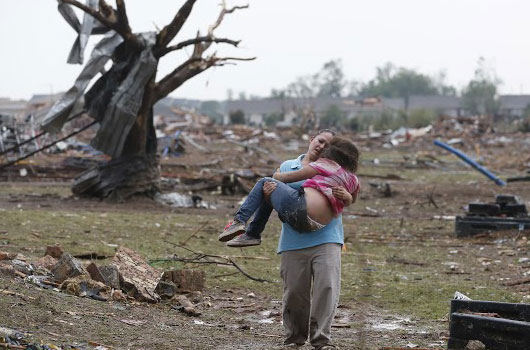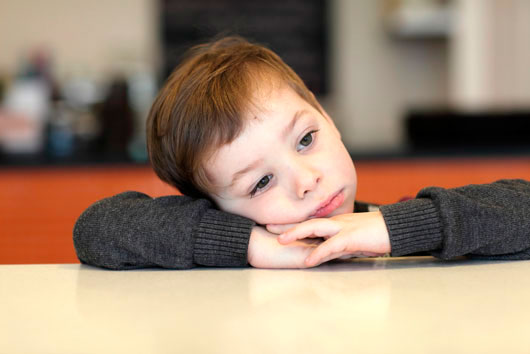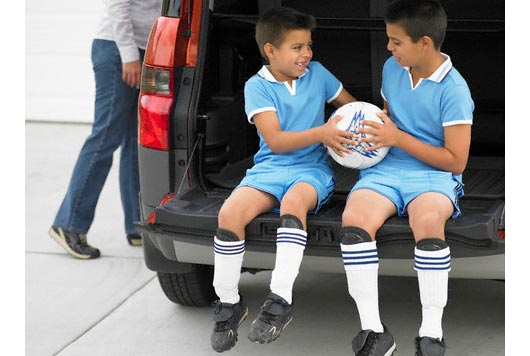We can’t shield our children from every disaster that gets reported on the news. Tragedies like 9/11, the Sandy Hook Elementary shooting, and the recent deadly tornado in Oklahoma are all too frequent, and our children will hear about them—and possibly see graphic images—whether we want them to or not.
“Disasters such as the Oklahoma tornadoes can cause fear, anxiety and stress in children, which can last long after the initial impact,” says Carolyn Miles, president and CEO for Save the Children.
“That’s why we have to do everything we can to minimize the emotional effect of such traumatizing events on children and provide the support they need.”
So how do we explain senseless violence and destruction to our kids, and reassure them at the same time? Save the Children offers these 10 tips, based on the organization’s decades of experience with helping children in emergencies.
10 TIPS TO HELP KIDS COPE WITH DISASTER
1. Limit TV time. Watching television reports on disasters can overwhelm younger children who may not understand an event is being replayed and instead think the disaster is happening over and over again. Overexposure to coverage of the events affects teenagers and adults as well.
2. Listen to your children carefully. Emotional stress results in part when a child cannot give meaning to dangerous experiences. Begin a dialog to help him gain a basic understanding that is appropriate for his age and responds to his underlying concerns.
3. Give children reassurance. Let them know that if any emergency or crisis should occur, your primary concern will be their safety. Make sure they know they are being protected.
4. Be alert for significant changes. Be aware of changes in sleeping patterns, eating habits,
concentration, wide emotional swings or frequent physical complaints without apparent illness. They will likely subside within a short time but if prolonged, we encourage you to seek professional support and counseling.
Read Related: Beginning to Heal After the Sandy Hook Tragedy
5. Expect the unexpected. As children develop, their intellectual, physical and emotional capacities change. Younger children will depend largely on their parents to interpret events, while older children and teenagers will get information from a variety of sources that may not be as reliable. While teenagers seem to have more adult capacities to recover, they still need extra love, understanding and support to process these events.
6. Give your children extra time and attention. They need your close, personal involvement to comprehend that they are safe and secure. Talk, play and listen to them. Find time to engage in special activities for children of all ages.
7. Be a model for your child. Your child will learn how to deal with these events by seeing how you deal with them. Base the amount of self-disclosure on the age and developmental level of each of your children. Explain your feelings but remember to do so calmly.
8. Watch your own behavior. Make a point of showing sensitivity toward those impacted by the disaster. This is an opportunity to teach your children that we all need to help each other.
9. Help your children return to normal activities. Children almost always benefit from activity, goal orientation and sociability. Ensure that your child’s school environment is also returning to normal patterns and not spending great amounts of time discussing the crisis.
10. Encourage your child to do volunteer work. Helping others can give your child a sense of control, security and empathy. In the midst of crisis, adolescents and youth can emerge as active agents of positive change.
Save the Children’s U.S. emergency response team is mobilizing staff and essential supplies to provide support, relief and recovery services to communities and families in Oklahoma.
Click here to help provide relief and support for children affected by disasters in the United States. You can also text TWISTER to 20222 to donate $10 to Save the Children and help the response effort. Standard rates apply.
Save the Children works to break the cycle of poverty and improve the lives of children by ensuring they have the resources they need—access to quality education, healthy foods, and opportunities to grow and develop in a nurturing environment. When disasters strike, like hurricanes and wildfires, Save the Children is among the first on the ground, ensuring the needs of children are being met.












